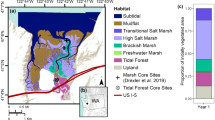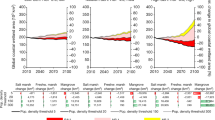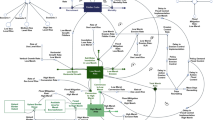Abstract
We analyse the potential impacts of sea-level rise on the management of saline coastal wetlands in the Hunter River estuary, NSW, Australia. We model two management options: leaving all floodgates open, facilitating retreat of mangrove and saltmarsh into low-lying coastal lands; and leaving floodgates closed. For both management options we modelled the potential extent of saline coastal wetland to 2100 under a low sea-level rise scenario (based on 5 % minima of SRES B1 emissions scenario) and a high sea-level rise scenario (based on 95 % maxima of SRES A1FI emissions scenario). In both instances we quantified the carbon burial benefits associated with those actions. Using a dynamic elevation model, which factored in the accretion and vertical elevation responses of mangrove and saltmarsh to rising sea levels, we projected the distribution of saline coastal wetlands, and estimated the volume of sediment and carbon burial across the estuary under each scenario. We found that the management of floodgates is the primary determinant of potential saline coastal wetland extent to 2100, with only 33 % of the potential wetland area remaining under the high sea-level rise scenario, with floodgates closed, and with a 127 % expansion of potential wetland extent with floodgates open and levees breached. Carbon burial was an additional benefit of accommodating landward retreat of wetlands, with an additional 280,000 tonnes of carbon buried under the high sea-level rise scenario with floodgates open (775,075 tonnes with floodgates open and 490,280 tonnes with floodgates closed). Nearly all of the Hunter Wetlands National Park, a Ramsar wetland, will be lost under the high sea-level rise scenario, while there is potential for expansion of the wetland area by 35 % under the low sea-level rise scenario, regardless of floodgate management. We recommend that National Parks, Reserves, Ramsar sites and other static conservation mechanisms employed to protect significant coastal wetlands must begin to employ dynamic buffers to accommodate sea-level rise change impacts, which will likely require land purchase or other agreements with private landholders. The costs of facilitating adaptation may be offset by carbon sequestration gains.




Similar content being viewed by others
References
Adams, C.A., J.E. Andrews, and T. Jickells. 2012. Nitrous oxide and methane fluxes vs. carbon, nitrogen and phosphorous burial in new intertidal and saltmarsh sediments. Science of The Total Environment 434: 240–251.
Allen, J.R.L. 1990. The Severn Estuary in southwest Britain: Its retreat under marine transgression, and fine-sediment regime. Sedimentary Geology 66: 13–28.
Alongi, D.M. 2008. Mangrove forests: Resilience, protection from tsunamis, and responses to global climate change. Estuarine, Coastal and Shelf Science 76: 1–13.
Alongi, D.M. 2012. Carbon sequestration in mangrove forests. Carbon Management 3: 313–322.
Bricker-Urso, S., S. Nixon, J. Cochran, D. Hirschberg, and C. Hunt. 1989. Accretion rates and sediment accumulation in Rhode Island salt marshes. Estuaries and Coasts 12: 300–317.
Burley, J., R. McAllister, K. Collins, and C. Lovelock. 2012. Integration, synthesis and climate change adaptation: A narrative based on coastal wetlands at the regional scale. Regional Environmental Change 12: 581–593.
Cahoon, D.R., P.E. Marin, B.K. Black, and J.C. Lynch. 2000. A method for measuring vertical accretion, elevation, and compaction of soft, shallow-water sediments. Journal of Sedimentary Research 70: 1250–1253.
Chmura, G.L., S.C. Anisfeld, D.R. Cahoon, and J.C. Lynch. 2003. Global carbon sequestration in tidal, saline wetland soils. Global Biogeochemical Cycles 17: 1111.
Costanza, R., R. d'Arge, R. de Groot, S. Farber, M. Grasso, B. Hannon, K. Limburg, S. Naeem, R.V. O'Neill, J. Paruelo, R.G. Raskin, P. Sutton, and M. van den Belt. 1998. The value of the world's ecosystem services and natural capital. Ecological Economics 25: 3–15.
Costanza, R., S.C. Farber, and J. Maxwell. 1989. Valuation and management of wetland ecosystems. Ecological Economics 1: 335–361.
Craig, R.K. 2010. “Stationary is Dead”—Long live transformation: five principles for climate change adaptation law. Harvard Law Review 34: 9–73.
DECCW. 2008. New South Wales National Parks Establishment Plan: Directions for building a diverse and resilient system of parks and reserves under the National Parks and Wildlife Act. Sydney: NSW Department of Environment, Climate Change and Water.
DEWHA. 2009. National Guidelines for Notifying Change in Ecological Character of Australian Ramsar Sites (Article 3.2). “Module 3 of the National Guidllines for Ramsar Wetlands—Implementing the Ramsar Convention in Australia”. Canberra: Department of Environment, Water, Heritage and the Arts.
Duarte, C.M., J. Middelburg, and N. Caraco. 2005. Major role of marine vegetation on the oceanic carbon cycle. Biogeosciences 2: 1–8.
Erfanzadeh, R., A. Garbutt, J. Pétillon, J.-P. Maelfait, and M. Hoffmann. 2010. Factors affecting the success of early salt-marsh colonizers: Seed availability rather than site suitability and dispersal traits. Plant Ecology 206: 335–347.
Ewel, K.C., R.R. Twilley, and J.E. Ong. 1998. Different kinds of mangrove forests provide different goods and services. Global Ecology and Biogeography Letters 7: 83–94.
Ford, M.A., D.R. Cahoon, and J.C. Lynch. 1999. Restoring marsh elevation in a rapidly subsiding salt marsh by thin-layer deposition of dredged material. Ecological Engineering 12: 189–205.
Fujimoto, K., T. Miyagi, T. Kikuchi, and T. Kawana. 1996. Mangrove habitat formation and response to holocene sea-level changes on Kosrae Island, Micronesia. Mangroves and Salt Marshes 1: 47–57.
Goodrick, G.N. 1970. A Survey Of Wetlands Of Coastal New South Wales. In Technical Memorandum No. 5, September 1970, 36 pp. plus plates. Canberra: CSIRO Division of Wildlife Research.
Grinsted, A., J. Moore, and S. Jevrejeva. 2010. Reconstructing sea level from paleo and projected temperatures 200 to 2100 AD. Climate Dynamics 34: 461–472.
Hashimoto, T.R., N. Saintilan, and S.G. Haberle. 2006. Mid-Holocene development of mangrove communities featuring Rhizophoraceae and geomorphic change in the Richmond River Estuary, New South Wales, Australia. Geographical Research 44: 63–76.
Horton, R., C. Herweijer, C. Rosenzweig, J. Liu, V. Gornitz, and A.C. Ruane. 2008. Sea-level rise projections for current generation CGCMs based on the semi-empirical method. Geophysical Research Letters 35, L02715.
Howe, A.J., J.F. Rodríguez, and P.M. Saco. 2009. Surface evolution and carbon sequestration in disturbed and undisturbed wetland soils of the Hunter estuary, southeast Australia. Estuarine, Coastal and Shelf Science 84: 75–83.
Hunter, J. 2010. Estimating sea-level extremes under conditions of uncertain sea-level rise. Climatic Change 99: 331–350.
Jevrejeva, S., J.C. Moore, and A. Grinsted. 2010. How will sea level respond to changes in natural and anthropogenic forcings by 2100? Geophysical Research Letters 37, L07703.
Kirwan, M.L., G.R. Guntenspergen, A. D'Alpaos, J.T. Morris, S.M. Mudd, and S. Temmerman. 2010. Limits on the adaptability of coastal marshes to rising sea level. Geophysical Research Letters 37, L23401.
Kirwan, M.L., and S.M. Mudd. 2012. Response of salt-marsh carbon accumulation to climate change. Nature 489: 550–553.
Krauss, K.W., J.A. Allen, and D.R. Cahoon. 2003. Differential rates of vertical accretion and elevation change among aerial root types in Micronesian mangrove forests. Estuarine, Coastal and Shelf Science 56: 251–259.
Krauss, K.W., C.E. Lovelock, K.L. McKee, L. López-Hoffman, S.M.L. Ewe, and W.P. Sousa. 2008. Environmental drivers in mangrove establishment and early development: A review. Aquatic Botany 89: 105–127.
Kwak, T.J., and J.B. Zedler. 1997. Food web analysis of southern California coastal wetlands using multiple stable isotopes. Oecologia 110: 262–277.
Lee, S.Y., R.J.K. Dunn, R.A. Young, R.M. Connolly, P.E.R. Dale, R. Dehayr, C.J. Lemckert, S. McKinnon, B. Powell, P.R. Teasdale, and D.T. Welsh. 2006. Impact of urbanization on coastal wetland structure and function. Austral Ecology 31: 149–163.
Lovelock, C., V. Bennion, A. Grinham, and D. Cahoon. 2011. The role of surface and subsurface processes in keeping pace with sea level rise in intertidal wetlands of Moreton Bay, Queensland, Australia. Ecosystems 14: 745–757.
Lynch, J.C., J.R. Meriwether, B.A. McKee, F. Vera-Herrera, and R.R. Twilley. 1989. Recent accretion in mangrove ecosystems based on 137Cs and 210Pb. Estuaries 12: 284–299.
Magenheimer, J., T. Moore, G. Chmura, and R. Daoust. 1996. Methane and carbon dioxide flux from a macrotidal salt marsh, Bay of Fundy, New Brunswick. Estuaries and Coasts 19: 139–145.
Mazumder, D., N. Saintilan, and R.J. Williams. 2006. Trophic relationships between itinerant fish and crab larvae in a temperate Australian saltmarsh. Marine and Freshwater Research 57: 193–199.
McKee, K.L. 2011. Biophysical controls on accretion and elevation change in Caribbean mangrove ecosystems. Estuarine, Coastal and Shelf Science 91: 475–483.
McKee, K.L., D.R. Cahoon, and I.C. Feller. 2007. Caribbean mangroves adjust to rising sea level through biotic controls on change in soil elevation. Global Ecology and Biogeography 16: 545–556.
McLeod, E., G.L. Chmura, S. Bouillon, R. Salm, M. Björk, C.M. Duarte, C.E. Lovelock, W.H. Schlesinger, and B.R. Silliman. 2011. A blueprint for blue carbon: Toward an improved understanding of the role of vegetated coastal habitats in sequestering CO2. Frontiers in Ecology and the Environment 9: 552–560.
Meehl, G.A., T.F. Stocker, W.D. Collins, P. Friedlingstein, A.T. Gaye, J.M. Gregory, A. Kitoh, R. Knutti, J.M. Murphy, A. Noda, S.C.B. Raper, I.G. Watterson, A.J. Weaver, and Z.-C. Zhao. 2007. Global climate projections. In In Climate Change 2007: The Physical Science Basis. Contribution of Working Group I to the Fourth Assessment Report of the Intergovernmental Panel on Climate Change, ed. S. Solomon, D. Qin, M. Manning, Z. Chen, M. Marquis, K.B. Averyt, M. Tignor, and H.L. Miller. Cambridge: Cambridge University Press.
Miyagi, T., C. Tanavud, P. Pramojanee, K. Fujimoto, and Y. Mochida. 1999. Mangrove habitat dynamics and sea-level change. A scenario and GIS mapping of the changing process of the delta and estuary type mangrove habitat in Southwestern Thailand. Tropics 8: 179–196.
Morris, J.T., P.V. Sundareshwar, C.T. Nietch, B. Kjerfve, and D.R. Cahoon. 2002. Responses of coastal wetlands to rising sea-levels. Ecology 83: 2869–2877.
Nicholls, R.J., N. Marinova, J.A. Lowe, S. Brown, P. Vellinga, D. de Gusmão, J. Hinkel, and R.S.J. Tol. 2011. Sea-level rise and its possible impacts given a ‘beyond 4°C world’ in the twenty-first century. Philosophical Transactions of the Royal Society A—Mathematical, Physical and Engineering Sciences 369: 161–181.
Nyman, J.A., R.J. Walters, R.D. Delaune, and W.H. Patrick Jr. 2006. Marsh vertical accretion via vegetative growth. Estuarine, Coastal and Shelf Science 69: 370–380.
Oliver, T., K. Rogers, C. Chafer, and C. Woodroffe. 2012. Measuring, mapping and modelling: an integrated approach to the management of mangrove and saltmarsh in the Minnamurra River estuary, southeast Australia. Wetlands Ecology and Management 20: 353–371.
Osland, M., A. Spivak, J. Nestlerode, J. Lessmann, A. Almario, P. Heitmuller, M. Russell, K. Krauss, F. Alvarez, D. Dantin, J. Harvey, A. From, N. Cormier, and C. Stagg. 2012. Ecosystem development after mangrove wetland creation: plant–soil change across a 20-year chronosequence. Ecosystems 15: 848–866.
Pethick, J. 2001. Coastal management and sea-level rise. Catena 42: 307–322.
Pittock, J., M. Finlayson, A. Gardner, and C. McKay. 2010. Changing character: the Ramsar Convention on Wetlands and climate change in the Murray Darling Basin, Australia. Environmental Planning and Law Journal 27: 401–425.
Poffenbarger, H., B. Needelman, and J. Megonigal. 2011. Salinity influence on methane emissions from tidal marshes. Wetlands 31: 831–842.
Primavera, J.H. 2006. Overcoming the impacts of aquaculture on the coastal zone. Ocean and Coastal Management 49: 531–545.
Ramsar. 2012. Resolution XI.14. Climate change and wetlands: implications for the Ramsar Convention on Wetlands. In Resolutions of the 11th meeting of the Conference of Parties to the Convention on Wetlands. Romania: Ramsar.
Rogers, K., and N. Saintilan. 2002. Remapping of the SEPP14 wetlands in the Shoalhaven district. Wetlands (Australia) 20: 55–65.
Rogers, K., N. Saintilan, and C. Copeland. 2012. Modelling wetland surface elevation and its application to forecasting the effects of sea-level rise on estuarine wetlands. Ecological Modelling 244: 148–157.
Rogers, K., K.M. Wilton, and N. Saintilan. 2006. Vegetation change and surface elevation dynamics in estuarine wetlands of southeast Australia. Estuarine, Coastal and Shelf Science 66: 559–569.
Roy, P.S., R.J. Williams, A.R. Jones, I. Yassini, P.J. Gibbs, B. Coates, R.J. West, P.R. Scanes, J.P. Hudson, and S. Nichol. 2001. Structure and function of South-east Australian Estuaries. Estuarine, Coastal and Shelf Science 53: 351–384.
Sammut, J., M.D. Melville, R.B. Callinan, and G.C. Fraser. 1995. Estuarine acidification: impacts on aquatic biota of draining acid sulphate soils. Australian Geographical Studies 33: 89–100.
Shoo, L.P., J. O'Mara, K., Perhans, J.R., Rhodes, R.K., Runting, S., Schmidt, L.W., traill, L.C., Weber, K.A., Wilson, C.E., Lovelock. (2013). Moving beyond the conceptual: specificity in regional climate change adaptation actions for biodiversity in South East Queensland, Australia. Regional Environmental change. doi:10.1007/s10113-012-0385-3
Silver, W.L., R. Ostertag, and A.E. Lugo. 2000. The potential for carbon sequestration through reforestation of abandoned tropical agricultural and pasture lands. Restoration Ecology 8: 394–407.
Spencer, J., V. Monamy, and M. Breitfuss. 2009. Saltmarsh as habitat for birds and other vertebrates. In Australian saltmarsh ecology, ed. N. Saintilan, 149–166. Collingwood: CSIRO.
Traill, L.W., K. Perhans, C.E. Lovelock, A. Prohaska, S. McFallan, J.R. Rhodes, and K.A. Wilson. 2011. Managing for change: wetland transitions under sea-level rise and outcomes for threatened species. Diversity and Distributions 17: 1225–1233.
Walsh, S., Copeland, C., Westlake M. 2004. Major fish kills in the Northern Rivers of NSW in 2001: causes, impacts and responses. In Fisheries Final Report Series No. 68: NSW Department of Primary Industries
Williams, R.J., Watford, F.A. 1997. Change in the distribution of mangrove and saltmarsh in Berowra and Marramarra Creeks. 1941–1992. In Report to Hornsby Shire Council. Cronulla, NSW: NSW Fisheries Office of Conservation, Fisheries Research Institute
Winning, G., and N. Saintilan. 2009. Vegetation changes in Hexham Swamp, Hunter River, New South Wales, since the construction of floodgates in 1971. Cunninghamia 11: 185–194.
Woodroffe, C.D. 1990. The impact of sea-level rise on mangrove shorelines. Letchworth, ROYAUME-UNI: Turpin.
Acknowledgements
Max Finlayson is thanked for his comments on approaches to climate change adaptation under the Ramsar Convention. We also thank David Hanslow (NSW Office of Environment and Heritage) for helpful advice and three anonymous reviewers. Part of this research was funded by the NSW Environmental Trust with support provided by Kooragang Wetland Rehabilitation Project.
Author information
Authors and Affiliations
Corresponding author
Rights and permissions
About this article
Cite this article
Rogers, K., Saintilan, N. & Copeland, C. Managed Retreat of Saline Coastal Wetlands: Challenges and Opportunities Identified from the Hunter River Estuary, Australia. Estuaries and Coasts 37, 67–78 (2014). https://doi.org/10.1007/s12237-013-9664-6
Received:
Revised:
Accepted:
Published:
Issue Date:
DOI: https://doi.org/10.1007/s12237-013-9664-6




